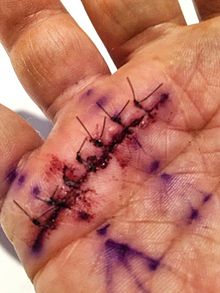

Trigger finger, trigger thumb, or trigger digit (also a sub-set of stenosing tenosynovitis) is a common disorder characterized by catching, snapping or locking of the involved finger flexor tendon, associated with dysfunction and pain. A disparity in size between the flexor tendon and the surrounding retinacular pulley system, most commonly at the level of the first annular (A1) pulley, results in difficulty flexing or extending the finger and the “triggering” phenomenon. The label of trigger finger is used because when the finger unlocks, it pops back suddenly, as if releasing a trigger on a gun.
Causes
The cause of trigger finger is unclear but several causes have been proposed. It has also been called stenosing tenosynovitis (specifically digital tenovaginitis stenosans), but this may be a misnomer, as inflammation is not a predominant feature.
It has been speculated that repetitive forceful use of a digit leads to narrowing of the fibrous digital sheath in which it runs, but there is little scientific data to support this theory. The relationship of trigger finger to work activities is debatable and scientific evidence for and against hand use as a cause exist. While the mechanism is unclear, there is some evidence that triggering of the thumb is more likely to occur following surgery for carpal tunnel syndrome. it may also occur in rheumatoid arthritis
Top of page
Diagnosis
Diagnosis is made almost exclusively by history and physical examination alone. More than one finger may be affected at a time, though it usually affects the index, thumb, middle, or ring finger. The triggering is usually more pronounced late at night and into the morning, or while gripping an object firmly.
Treatment

Injection of the tendon sheath with a corticosteroid is effective over weeks to months in more than half of patients.
When corticosteroid injection fails, the problem is predictably resolved by a relatively simple surgical procedure (usually outpatient, under local anesthesia). The surgeon will cut the sheath that is restricting the tendon.
Studies in the Journal of Hand Surgery suggests that the most cost-effective treatment is two trials of corticosteroid injection, followed by open release of the first annular pulley. Choosing surgery immediately is the most expensive option and is often not necessary for resolution of symptoms. More recently, a randomized controlled trial comparing corticosteroid injection with needle release and open release of the A1 pulley reported that only 57% of patients responded to corticosteroid injection (defined as being free of triggering symptoms for greater than 6 months). This is compared to a percutaneous needle release (100% success rate) and open release (100% success rate). This is somewhat consistent with the most recent Cochrane Systematic Review of corticosteroid injection for trigger finger which found only 2 pseudo-randomized controlled trials for a total pooled success rate of only 37%.
Top of page
Prognosis
The natural history of disease for trigger finger remains uncertain.
There is some evidence that idiopathic trigger finger behaves differently in people with diabetes.
Recurrent triggering is unusual after successful injection and rare after successful surgery.
While difficulty extending the proximal interphalangeal joint may persist for months, it benefits from exercises to stretch the finger straighter.





